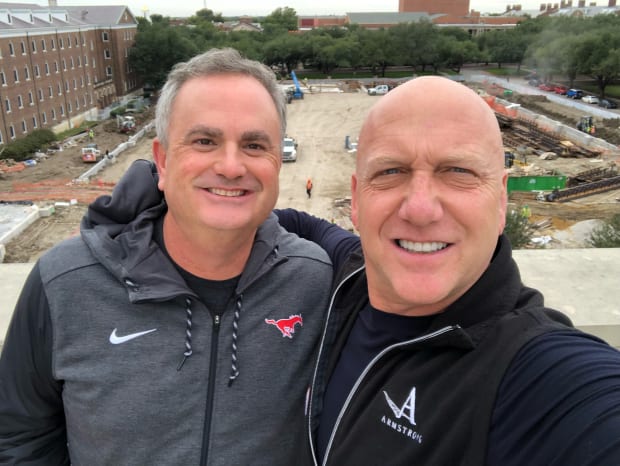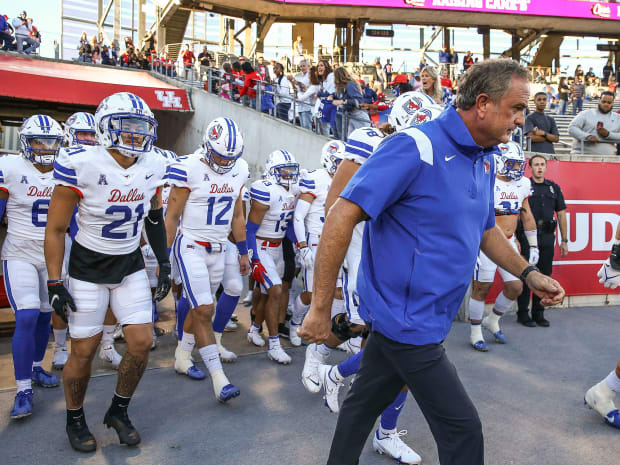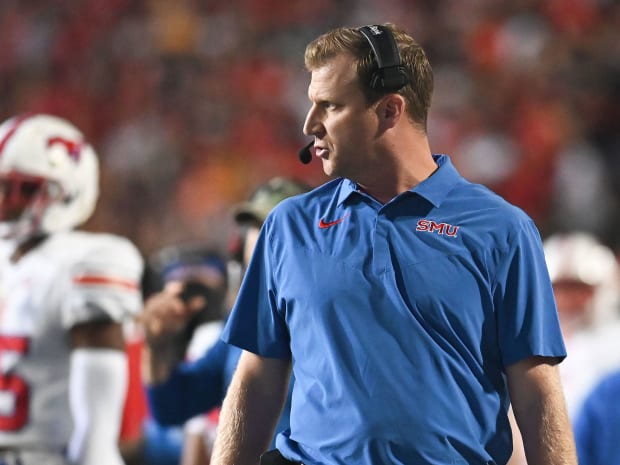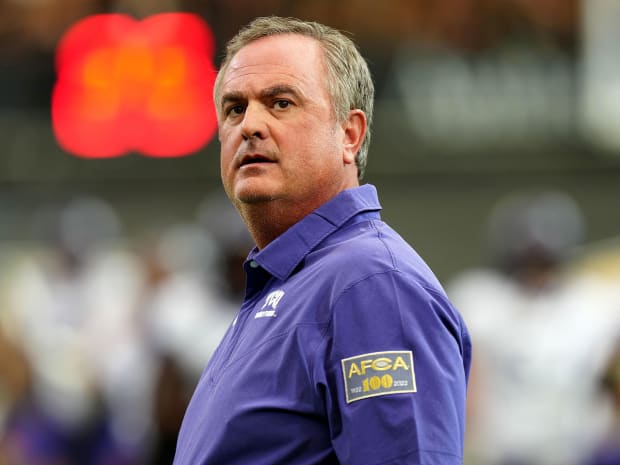At Le Bilboquet, a boutique French bistro in Dallas, the servers know Bill Armstrong well enough to refer to him by his first name.
Bill, they say, likes to sit on the patio for dinner. They know Bill’s “usual” order. Sometimes, Bill eats here twice a day. He’s had the fish, chicken and the steak, and he has tested his seasoned pallet on many of the wines (Bill and wife Elisabeth own a California winery).
Slender and tall, Bill arrives at the restaurant dressed as one would expect from a second-generation Texas oil man—jeans and a button-down. Bill is worth millions, some of which he’s pumped into his alma mater, Southern Methodist. For instance, SMU’s 3-year-old fieldhouse bears his last name, and so does a campus dormitory. He says he and Elisabeth have donated roughly $30 million to the school.
Bill Armstrong is so involved in SMU athletics that he and former football coach Sonny Dykes developed a close enough relationship to travel together, host family outings and dine across from each other here at Bilboquet. In happier days, Bill says, he and Dykes shared laughs, food and drinks from under this place’s covered patio. So forgive him if still, 10 months later, he feels betrayed and bamboozled by the coach’s decision to leave SMU for crosstown rival TCU.
“It’s like I got broken up with,” says the 62-year-old Armstrong, who points the finger back at himself. “I’m like, ‘Grow up, Bill!’ I probably was too close. I was a fanboy.
“But we do feel hurt,” he continues. “We feel stabbed in the back.”

Courtesy of Bill Armstrong
It’s a big week here in Dallas. The 101st edition of the series between SMU and TCU has been billed as if it is a nightmarish box-office sequel: The Return of Sonny. Dykes’s decision last November is believed to be the first in the modern era of major college football that a head coach has left one school to directly join its primary, in-state rival. The move elicited such vitriol among Mustangs fans that Dykes, at first hoping his family could remain in Dallas through the end of the school year, immediately moved them to Fort Worth to save his wife and three children from the nasty aftermath. It’s bad enough that, as of last month, Dykes was planning to keep his kids from attending this weekend’s game at the 32,000-seat Gerald J. Ford Stadium.
The hate here is real, and it’s not only from SMU fans, says Paul Grindstaff, the former president of the Mustang Club. “The players have known what Sept. 24 has in store for them,” Grindstaff says. “Everyone’s known the date ever since that stuff went down.”
The duel between the Mustangs (2–1) and the Horned Frogs (2–0), despite both being unranked, is rife with so much anticipation that officials are expecting a record crowd. The cheapest tickets on the secondary market are priced at $200 apiece. Extra security and police officers will be at the game, officials say.
After all, this is a historically unique situation. Sure, it’s happened in plenty of other sports. Just recently, Texas Tech men’s basketball coach Chris Beard moved to Texas and TCU’s baseball coach, Jim Schlossnagle, left for Texas A&M. But this isn’t that. And it isn’t Tyrone Willingham leaving Stanford for Notre Dame. It’s not Tommy Tuberville trading Ole Miss for Auburn. Or Doug Dickey in 1970 bailing on Tennessee for Florida.
This is different.
“What happened to SMU and Sonny is no different than Lincoln Riley and OU or Brian Kelly and Notre Dame,” Armstrong says, “except he went to a crosstown rival.
“There’s not a lot of love lost.”
Chris Del Conte knows what it’s like to leave one Texas school for a rival Texas school.
He spent nine years as TCU’s athletic director before joining Texas in 2017. On his first trip back to Fort Worth for a football game, he put armed guards at the door of his suite.
“These in-state games matter,” Del Conte says. “This one [SMU-TCU] goes way back to the two cities, Fort Worth against Dallas. Someone has made the comment that if you want to go to Dallas, you might as well go to Atlanta. If you want to go to Texas, you go to Fort Worth.
“One is cowtown, and the other is cosmopolitan.”
Cowtown leads the series 51-42-7 and has won 17 of the last 21 games, most of that with Gary Patterson atop the program (Patterson lost four games to SMU in 19 tries and outlasted five SMU coaches). However, the cosmopolitan Mustangs have won back-to-back games in the rivalry for the first time in 30 years.
The man who helped swing the pendulum now presides over the other. Having been fired at Cal, Dykes arrived at SMU in 2018 after a one-year analyst position at, wouldn’t you know it, TCU. In Year 2, he delivered the most wins at SMU (10) since the days of the Pony Express in 1984.

Troy Taormina/USA TODAY Sports
He tactfully used the transfer portal, developed a marketing campaign to take advantage of SMU’s place in the center of the U.S.’s ninth-largest city and landed prized talent in one of the country’s most fertile recruiting areas. His tenure coincided with an investment wave that the athletic department hadn’t seen in decades. Athletic director Rick Hart and a bevy of passionate boosters launched a fundraising effort that resulted in the 2019 completion of the $150 million Indoor Performance Center.
And then, despite an offered new contract and the commitment of more facilities upgrades, Dykes left. It happened in a manner that even he regrets. “Sometimes you think that these things are going to go differently than they do,” Dykes says. “Some of that stuff turned more personal than I thought. My family certainly got that feeling when I’d come over here and they were still in Dallas.”
Reports linking him to the TCU job began trickling out within hours of the Horned Frogs parting ways with Patterson on Oct. 31. At that point, the Mustangs were 7–1. They then lost three of their last four games. On the eve of the finale against Tulsa, multiple outlets reported that TCU planned to hire Dykes after the season.
Things became so public that Hart says he spoke to Dykes about whether it was best for him to coach that final game. They agreed it was. SMU lost, 34–31.
“I like to learn from my experiences and not hold regrets,” Hart says. “I learned I never want to be in that situation again.”
Hart says Dykes never used SMU for leverage. Regular conversations with the coach last November were transparent and honest. And while nothing was official until after the final game—TCU announced the hire less than 48 hours later—Hart had a strong suspicion he’d have a job to fill, so strong that he began to interview candidates.
While the Mustangs played out the 2021 season, their athletic director flew across the country meeting with coaches—a proactive approach, but also one that felt awkward. “I had to say to candidates, ‘I’ve got a head coach, but if I don’t have a head coach in a few weeks, would you be interested?’”
As a 29-year-old offensive coordinator for the national champion runner-up Auburn Tigers, Rhett Lashlee figured, soon enough, he’d be a head coach. That was 2013. “You expect things to happen a little faster or think they should,” Lashlee says from his office at SMU, where, nine years later, it finally happened.
He interviewed for at least one head job every season he was on the staff at Auburn, including that first year in 2013, when the Tigers lost to Florida State in the final BCS title game. He was often a finalist, something that only intensified the itch. The pursuit of such a job, in part, led him away from Auburn.
After the 2016 season, Lashlee left the side of coach Gus Malzahn as a child might move out of his parents’ home and explore the world himself. He worked as offensive coordinator at UConn for a year, SMU for two under Dykes and the last two at Miami.
“You’re working for Gus and it’s a ‘Is he doing it? Are you doing it? Are you doing it together? Can you do it on your own?’” says Lashlee. “If I was going to develop and take the next step, I needed to go out and totally do it and fail, sink or swim. It’s a leap of faith. It’s all worked out.”
That’s evident as he sits in the middle of an office he’s having remade. Lashlee took over a roster that featured plenty of players he recruited here while he coordinated the offense in 2018 and ’19. He’s familiar with this place. A boy from northwest Arkansas, Dallas suits him. And his former boss and predecessor knew it as well.
Dykes not only endorsed Lashlee for the job, but the two discussed the possibility last November. “Sonny and I had talked throughout the season,” says Lashlee, 39. “I knew if he had a chance to leave and if I had a chance at the job, I’d want it.”
Lashlee and Dykes remain close. Their families are tight. Their wives still communicate fairly often, and their children are friendly with one another. There is no hate here. There is, of course, competition. Above anything else, SMU vs. TCU is about gaining a year-round recruiting edge in the Dallas–Fort Worth metro area. The rosters of the two teams feature a combined 85 players from the metroplex.
“It’s not about Sonny and I,” Lashlee says. “This is huge for recruiting.”

Tommy Gilligan/USA TODAY Sports
Lashlee enters a fairly ideal situation. In the rapidly changing climate of college athletics, SMU is positioned to take advantage of both name, image and likeness (NIL), as well as conference realignment. It’s no secret that the school is open to a promotion to the ACC, Pac-12 or Big 12.
The Mustangs have won more games in a three-year period (25) for the program since the mid-1980s. The school is in the heart of a massive metro area, and its donors are buying in more than ever. The Mustang Club broke an all-time fundraising record this past fiscal year, reaching $73 million in gifts from 3,105 donors. The school plans to break ground this offseason on a $100 million end zone complex that will house a football operations center, premium seating and training table.
As for NIL, SMU is embracing its checkered past, conjuring up memories of those 1980s days when the NCAA slammed the program with the infamous death penalty for offering similar benefits to players that have now been legalized. The school recently invited back its two stars from that era, Craig James and Eric Dickerson, to shoot a video that it published earlier this month, both players riding around in one of the infamous symbols of the ’86 NCAA investigation—a TransAm. In fact, earlier this spring, Dickerson announced that he’d be part of a booster-led group planning to donate more than $1 million a year to pay SMU athletes to use their NIL.
“The death penalty, there’s a reason it hasn’t been dealt to anyone else since,” says Lashlee. “It cost us a generation of fans. There was a period there where there wasn’t football for a few years, and then when there was, it was at a level that didn’t allow SMU to compete.
“Just because everyone is doing it doesn’t make something O.K., but what happened 40 years ago is everyone was doing it and one school got punished.”
The death penalty still lingers here like a cloud. There is a perception about this place, a misconception and misunderstanding, officials say. Some at SMU believe that the near 40-year-old ruling has kept the school from being elevated to a Power 5 league. Others contend that something else is at play.
“Lots of people at SMU think TCU kept us out of the Big 12 in the last realignment,” says Armstrong.
Across town, nestled in his new office, Dykes finds himself in an unenviable position. He’s taking over for a coaching legend who, despite having a statue of himself outside of the stadium, was fired midway through his 21st season.
“It’s very unusual,” Dykes says. “There’s a high bar here.”
The Texas collegiate coaching ranks are an intermingling web of connections. In this story alone, Dykes worked for Patterson and Lashlee worked for Dykes. Without Patterson hiring him in 2017 at TCU, is Dykes the Horned Frogs coach? Without Dykes hiring Lashlee in ’18, is he SMU’s coach?
While Dykes and Lashlee meet this weekend, Dykes and Patterson face off on Nov. 12 in Austin. Patterson is a defensive analyst at Texas. “I’m all good with him,” Patterson says of Dykes. “The thing that you always know is that change is going to happen. I just outlasted a lot more than most.”
Dykes’s rebuild is off to a solid start. The Horned Frogs won at Colorado, 38–13, and then beat FCS Tarleton at home, 59–17. They were on a bye last week while Lashlee’s Mustangs lost a tight, physical bout at Maryland, 34–27.
As The Return of Sonny approaches, those at SMU are still baffled about last November. While Dykes says that SMU leaked the story before the season finale, one SMU booster claims that TCU committed “tortious interference,” when an entity wrongfully interferes with another’s contractual relationship. “A better way to put it: Our student-athletes had four games stolen from them,” says Grindstaff.
Armstrong says he knew Dykes was leaving for TCU before the game against Cincinnati, an entire week before the season finale. He was disappointed. Upon his hire, Dykes told SMU boosters that he wanted to be “the Gary Patterson of SMU,” says Armstrong.

Ron Chenoy/USA TODAY Sports
Armstrong isn’t used to losing bidding wars for anything, let alone football coaches. He’s the CEO and founder of Armstrong Oil & Gas Inc., an exploration and production company headquartered in Denver. In a story in 2019, The Wall Street Journal called him one of the nation’s “last oil wildcatters,” a hunter for oil pockets never before found. In ’13, his company made the largest oil discovery in decades on Alaska’s northern slopes. The company sold its stake in the discovery for an initial price of $400 million, a figure that could rise to $850 million.
The point is, Armstrong told Dykes he wouldn't be outbid. The Mustangs were willing to nearly double Dykes’s salary. A new contract with a yearly price tag of $4 million had been presented to him weeks before the TCU job opened.
It sat on his desk and was never signed. “It wasn’t about money,” says Armstrong.
So what was it about?
“It’s like anything else,” Dykes starts. “At SMU, we went about as far as we could go at that stage of the program. When you have that feeling, you think, ‘It’s probably best for me to move on.’ I think had we not felt that way, we would have stayed there forever. I just felt that maybe the program wasn’t growing at the rate that I felt like it needed to.”
For months since his departure, many at SMU believe Dykes left to join a school in the Power 5. That’s not true, the coach says. There were also rumblings that he left because of a lack of investment in the SMU program.
“Some stuff didn’t go the way I hoped it would as we started talking,” Dykes says. “The timing of things didn’t go as I thought. More than anything else, there was a little bit of a laissez-faire attitude. ‘We’ll get to this when we get to it!’ I didn’t feel like it was that big of a priority.
“‘If that’s the case and you’re not happy with it, then you need to take your ball and go play somewhere else.’ That’s kind of what I did.”
There is pushback against such a statement from those in the cosmopolitan camp. They point to the fundraising and facilities projects. “We weren’t going back and forth,” Hart says of the negotiations. “I confirmed his priorities. We offered an extension that met those priorities.”
Hart and Dykes don’t have the relationship that Hart would prefer, he says. Why? “He landed at an in-state, longtime rival,” the AD says. Says Dykes: “There’s some friendships that I’m hoping time will heal.”
At TCU, athletic director Jeremiah Donati received his share of backlash from the fans across town. He was flooded with ugly emails and hate messages on Twitter.
“That’s the hard part about our business,” Donati says. “When you leave a job, fans are hurt by that and take it personally. Anyone in our profession oughta be doing what’s best in the interest of their family. Other folks don’t see it that way.”
And so, on Saturday at Gerald J. Ford Stadium, The Return of Sonny arrives, in all its glory, luster and attitude.
Before kickoff, the school has a surprise planned. On Friday, SMU will make a splash with an announcement of a major donation to the end zone project. It just so happens that it is dropping this news a day before the clash with its former coach.
“Hey,” chuckles Hart, “I don’t control when people want to make their pledge.”
The person making this specific pledge is none other than a heartbroken, second-generation Texas oil man who used to dine with a certain coach at a fancy French bistro in Dallas’s Highland Park neighborhood.
Texted earlier this week for follow-up questions, Armstrong sent a GIF from the movie Lady and the Tramp. In the GIF, the two dogs are sharing a plate of spaghetti, slurping noodles together with big smiles on their faces. The GIF came with a message.
“Sonny and I in happier times,” he’d written.







